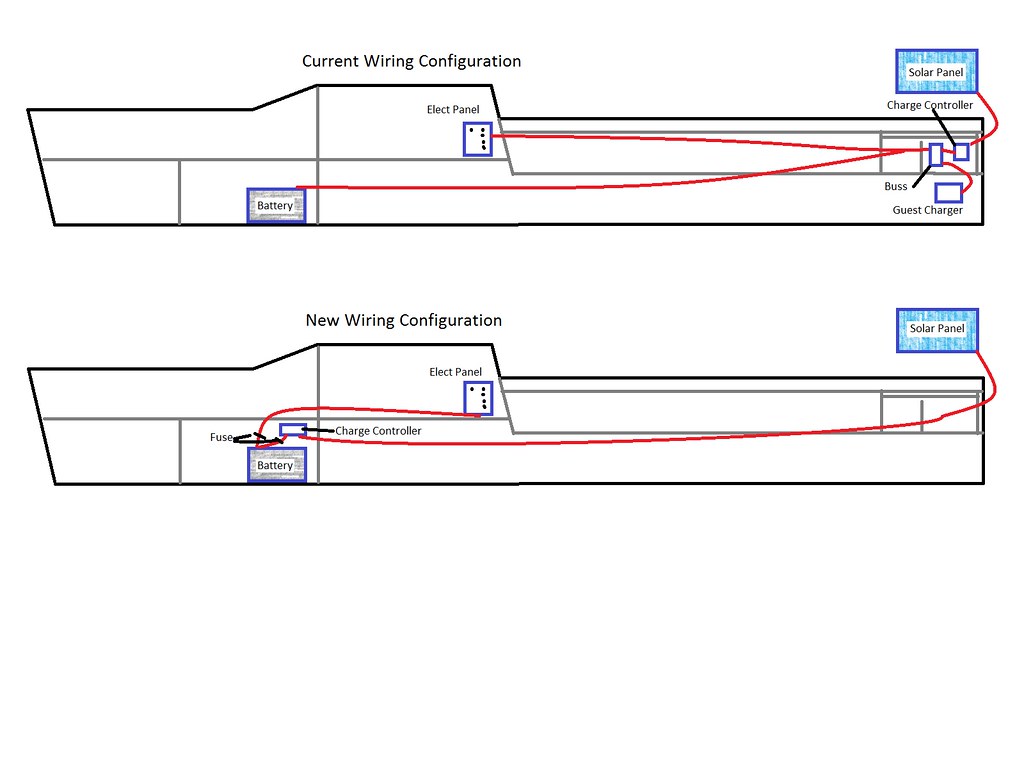Sunday morning I pulled Verboten into the driveway and got to work. First half of the day (demolition) actually went pretty well. I disconnected the battery, then went to the stern and cut apart the wiring in the old battery box. The stock wiring for a Capri 22 Mark II is 10 AWG. Imagine my surprise when I found the wire running from the battery in the v-berth was 16 AWG! Yikes, talk about too small!
Once I had things cut apart I pulled out the original wires and ran them forward as far as they'd go. That turned out to be about 1/3 of the way through the quarterberth locker. No problem, I thought, I've got 20 feet of wire for the solar panel run, I'll have plenty. NOT! Turns out the run from the battery box to the v-berth is longer than the boat! Who knew! So I went and bought more wire (8 feet each of red & black). Which wasn't enough, either.
At this point I had the wire run from the solar panel to the new charge controller done, though the controller wasn't mounted in the v-berth locker yet. The wire run from the panel to the same locker was done too and ate up more of that 8 feet of wire than I expected. I spent quite a bit of time mulling over placement of the switch and trying to figure out how to get the bits I hadt left to work. Nope, can't do it. By that time it was around 5:00, the temps were dropping, and the halogen light was no longer keeping the cabin warm. Plus I ached all over. So I called it a night.
This morning I woke up to snow! Not what I really wanted to see, especially since it was over a layer of frozen fog. I ran to Napa and picked up 2 more 10' spools of wire. No snow closer to town. Weird. Oh yeah, the partial gallon of distilled water I left in the boat was full of ice. Yeah, it was cold in there.
While Deborah was in town I got to work. First order of business was fitting a 3 way switch into the side of the v-berth. I don't have a 2-5/8 hole saw so it was dremel to the rescue. About 30 minutes of work gave me a round(ish) hole that was a perfect fit for the switch, and a big pile of powdered fiberglass in the locker to vacuum up.
Once the mess was cleaned up I mounted the solar charge controller in the locker and connected the wires from the solar panel, which already had ring terminal ends on them. I ran the wires for the connection to the battery, then went to work on connecting the ends and hooking everything up. I salvaged the buss from the original setup in the stern, and used it to gang together the negative wires, then started on the swiitch. Guess who was 2 ring terminals short. D'oH! Must be time for lunch and a break. Got the portable 120v charger out of the shed and hooked it up to try and get a full charge on the battery then went in to warm up and eat..
Deborah got home after a bit so back to the auto parts store for more ring terminals. I hooked things up and . . . nothing! WTF?! Time to start checking things over. Continuity seems to be fine, the switch is working as expected, so what's the problem? A bit of monkeying with things and I figured out that the master breaker on the main panel wasn't working quite right. It was sticking and wasn't actually turned on. Hmm. Hopefully that was just a symptom of the freezing cold weather and not something that I'll have to replace in the spring.
Once everything was working I decided to try hooking up the "load" on the charge controller to the #2 position on the switch instead of the charger wire, which I tied off to the #1 with the battery. Even with the switch in the off position I got a circuit that way. Not sure I completely understand why but the switch internals apparently don't work the way I think they do. Went back to the original plan and I'll do something else with the load; maybe a 12v fan.
Got things cleaned up (what a mess I made!) and ran the boat back down to the lockup around 4 PM.
So, I've now got 2 clean wiring paths on appropriately sized wire. Setting the switch to #1 turns on just the battery; #2 is just the solar panel, which makes the LED lights flicker, so maybe not too useful; 1+2 is the winner with both the battery and the solar panel. #0 turns everything off, which is probably a good choice when we're on the road towing.



